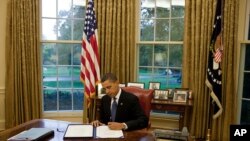Every few years, the Executive branch of the U.S. government, that is, the President, his Cabinet and support staff, prepares a National Security Strategy for the U.S. Congress. This document outlines the major national security concerns of the United States and how the administration plans to deal with them. On May 27, 2010, the Obama administration issued its first National Security Strategy, only the third of this decade.
Commenting on the Strategy, Secretary of State Hillary Clinton said “our overriding objectives [are]: security, prosperity, the explanation and spread of our values, and a just and sustainable international order.” She acknowledged that the world that we confront today has changed, and we must look at it in a much more comprehensive way. "It is not so much about the conflicts between powers, but the new and complicated threats that underscore and drive much of the interaction between powers in the world today: terrorism, proliferation, climate change, cyber security, energy security, and many other forces at work in our world.
"We are in a race between the forces of integration and the forces of disintegration," said Secretary Clinton, "and part of our challenge is to define American leadership in relevant terms to the world of today and tomorrow. So in a world like this, American leadership isn’t needed less, it’s actually needed more. And the simple fact is that no significant global challenge can be met without us."
According to the National Security Strategy, the Obama Administration is pursuing a strategy “to resolve the challenges of our times - countering violent extremism and insurgency; stopping the spread of nuclear weapons and securing nuclear materials; combating a changing climate and sustaining global growth; helping countries feed themselves and care for their sick; resolving and preventing conflict, while also healing its wounds."
To achieve these goals, the U.S. will work with traditional allies, while building relationships with "other 21st century centers of influence - including China, India, and Russia."
"Our long-term security will come not from our ability to instill fear in other peoples, but through our capacity to speak to their hopes," said President Barack Obama in his written introduction to the Strategy. "And that work will best be done through the power of the decency and dignity of the American people – our troops and diplomats, but also our private sector, nongovernmental organizations, and citizens. All of us have a role to play."
The Obama administration issued its first National Security Strategy, only the third of this decade.



















